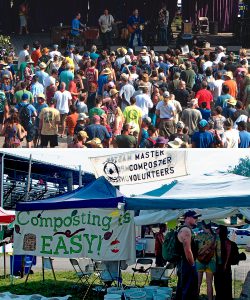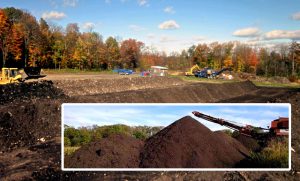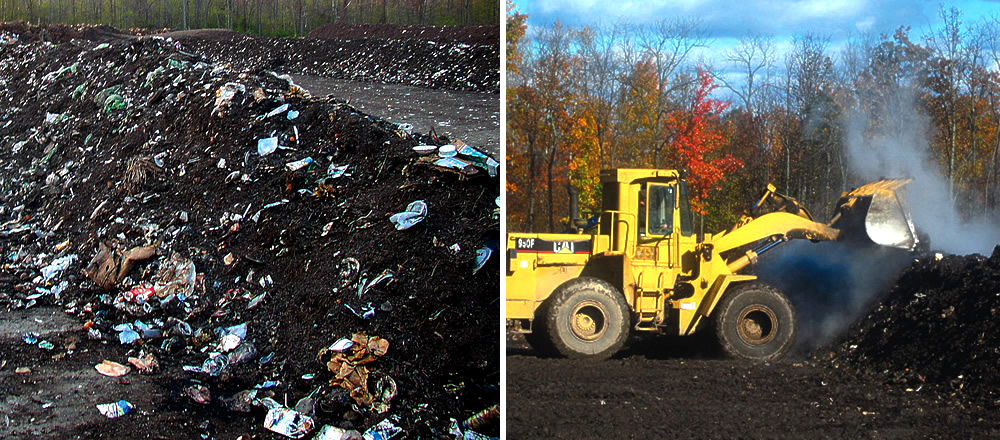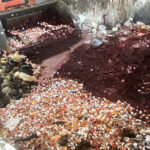The Finger Lakes GrassRoots Festival draws about 20,000 people to the 4-day event. Compost Crew volunteers, many of them Master Composters, run the organics diversion program.
Claire Siegrist and Dori Chandler
BioCycle September 2014

Compost education booth (bottom)
staffed by Master Composters, teaches festival goers (top) about home and large-scale composting, as well as offers compost-themed lawn games.
The 24th annual Finger Lakes GrassRoots Festival of Music and Dance was held in mid-July at the Trumansburg Fairgrounds in Trumansburg, New York. Approximately 20,000 people gather every year to watch more than 70 bands and musicians, representing genres from bluegrass to rock and roll, over the course of the four days. Festivalgoers generate a significant amount of waste, making a waste management plan and passionate volunteers essential to the green mission of the GrassRoots organization. Throughout the 19 years of food scraps recycling at GrassRoots, a total of 155,700 pounds (78 tons) of organics have been diverted from the landfill. In 2014, over 8.5 tons of organics were sent to Cayuga Compost, a composting facility located less than 2 miles from the fairgrounds.
The GrassRoots organizers rely on Compost Crew volunteers, who are rewarded with a free 4-day pass to the festival. Composting educational messages are included in the festival brochure, and organizers made announcements on all four stages about recycling and composting, and helped coordinate logistics with Cayuga Compost. Employees of Cayuga Compost collected and replaced full or half-full totes daily during the festival (and for about two weeks afterwards during post-festival clean up). The company provided 164 64-gallon totes and ten 90-gallon totes for organics collection, weighed the contents, and were on call as needed.
Avi Miner and Adam Michaelides organized the festival’s Compost Crew through the Cornell Cooperative Extension of Tompkins County (CCETC). Many of the crew coordinators and volunteers were trained through CCETC’s Master Composter Program, which currently has 90 active volunteer Master Composters and is funded entirely by the Tompkins County Solid Waste Management Division. The Compost Crew included 10 volunteer coordinators, including Miner and Michaelides, who attended pre and post festival meetings and supervised the 28 additional compost volunteers. In total, the Compost Crew volunteers contributed over 525 hours to the festival. Most crew members attended a 2-hour training session the week prior to the festival to ensure they knew their responsibilities long before their shifts started. After 19 years of composting at GrassRoots, Michaelides, Minerand and the other Master Composters have gotten the GrassRoots composting operation down to a science.
Throughout the 4-day festival, the Compost Crew collected food scraps from vendors an average of 9 times per day; serviced the unstaffed Compost, Recycling, Trash (CRT) stations at least 6 times per day; removed contamination from collection containers, tamped down food scraps, switched out full 64- and 90-gallon totes and 5-gallon buckets used for collection with empty ones; and educated over 400 festival attendees at the compost education booth about the many methods of home and large-scale composting. The booth also offered lawn games for the kids, including compost-themed Twister, and a worm bin filled with red wigglers. A Compost Theatre performance was included at the kids’ tent.
Master Composter Tim Miller championed a program to provide 5-gallon buckets to all overnight campers for food scraps collection. Miller collected roughly 150 buckets from a local supermarket bakery, and GrassRoots provided ample straw to use for the bottom of the buckets. The free buckets were handed out to campers as they entered the festival to set up their campsites. Campers were instructed to empty full buckets into large totes located in the campsite areas, which were serviced multiple times daily by the Compost Crew. Campers were able to take the buckets with them after the festival to use for home composting.
Managing Contaminants
A significant amount of contamination of the totes and buckets occurred after dark, so these were covered after dark to deter disposal of inorganic waste. In the morning, the totes were opened and any contaminants were removed. “Contamination is the number one enemy at the festival,” Michaelides says. “The number two enemy is not collecting all materials that can be composted.”
This year, a major contaminant was recyclable plastic cups. GrassRoots organizers required food vendors to provide either compostable or recyclable tableware. However, the visual similarity of compostable and recyclable cups led festivalgoers to discard the cups incorrectly. (No signage was provided at collection bins to help distinguish between the two.) Other typical contaminants included foil-surfaced paper, soy sauce packets and cans. The Compost Crews did a quick sort of the top of the organics bins at least six times a day to remove these contaminants. Although a few aluminum and plastic contaminants were sent to Cayuga Compost, the Compost Crew’s sorting was appreciated by the composting facility.
Compostable forks, knives and spoons used at the festival have become a challenge at Cayuga Compost due to the facility’s inability to break down these products. The composter will stop accepting these utensils at the beginning of 2015. Anticipating this change, Michaelides and the Compost Crew educated festivalgoers on the issue and asked them not to throw the compostable utensils in the compost bins. Signs were added to the bins to inform festivalgoers to throw these utensils in the trash, however, they were not very clear.
In addition to the Compost Crew, the Compost Recycling Trash Crew (CRT) and the Trash/Recycling Crew also managed waste from the festival. “The role of the CRT Crew is to be the educational component of waste management,” explains Jeremy Betterly, crew coordinator. “We tell people how to separate their compostables, recyclables and trash into the right bins.” He adds that it is important to “educate enough of a critical mass” in order for attendees to know how to separate their materials for the rest of the festival.
The Trash/Recycling Crew brought bags of trash and recycling, as well as loose cardboard, to the appropriate corrals. Cans were collected and sorted for redemption, while cardboard was collected in its own dumpster to maximize space. The Trash/Recycling Crew got into the dumpsters and jumped around a bit to tamp down the material, which helped to minimize the costs of trash/recycling pick ups and keep the dumpsters from overflowing. Planning and collaboration between the three waste management crews was essential, and will be improved for next year’s festival.
Food Donation, Collection Tweaks
Another essential part of festival waste minimization is food waste prevention through food donation. A few years ago, the composting of 1,000 pounds of leftover bagels alarmed a GrassRoots volunteer, who set out to find local places to donate the additional food. Today, a substantial amount of leftover food is donated at the end of the festival. Food ingredients, prepared and unprepared, are donated to local food pantries.
Throughout the years, composting at GrassRoots has seen many changes. “When composting at the festival first started, it was on site and very small-scale,” Michaelides explains. “We had an army of welded wire bins that a farmer would take away. Having this on site was a great educational piece; however, we wanted to reclaim more organics. When we started working with Cayuga Compost in 2007, the way we did things changed greatly. We went from buckets and wagons to totes.”

Cayuga Compost services the totes and composts the festival food scraps and compostable serviceware.
An important way to continue the program’s development is to experiment with different approaches to organics collection and waste management. For example, in 2013, the GrassRoots Compost Crew tried to save on expenses by carrying source separated organics in compostable bags to a dedicated dumpster. Although this system was cheaper than using totes, it caused problems due to bags ripping and melting. This year, GrassRoots and the compost coordinators jointly decided against the bags and negotiated a flat fee of $4,000 for Cayuga Compost’s services and totes. The flat fee contract was independent of the number of totes collected and meant that tote tamping (compressing the organics with tampers) might have been unnecessary work for the Compost Crew this year.
The next big step in the composting program’s evolution could culminate in use of reusable dishes and silverware at the festival. “Using and washing reusable dishes at GrassRoots would greatly help reduce the carbon footprint of the festival,” Michaelides notes. “This is the new frontier for making the festival more ‘green’.” Ideally, GrassRoots could invest in dishwashing machine(s); otherwise volunteers would be needed to hand wash dishes. GrassRoots would provide the dishes and silverware that could go with the festival when it travels to its alternate locations in Florida and North Carolina. Using reusable tableware would alter organics collection dramatically — swapping out totes and tampers for dish scraping.
Claire Siegrist is studying Natural Resources Planning and Management at Cornell University. She also educates students about proper waste management practices through work as a Sustainability Coordinator at Cornell. Dori Chandler is an Urban Planner and Environmental Consultant living in Ithaca, New York. She is assisting Tompkins County in implementing its first curbside food scraps recycling program.













